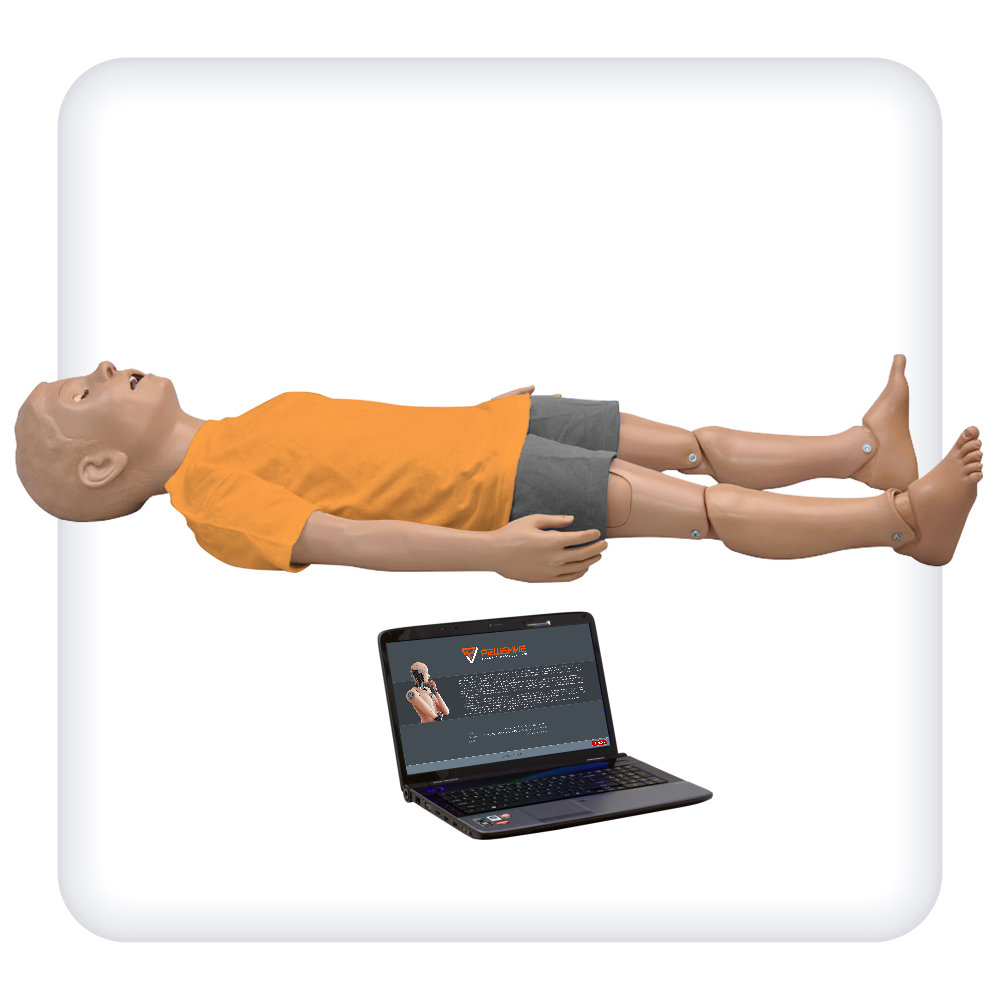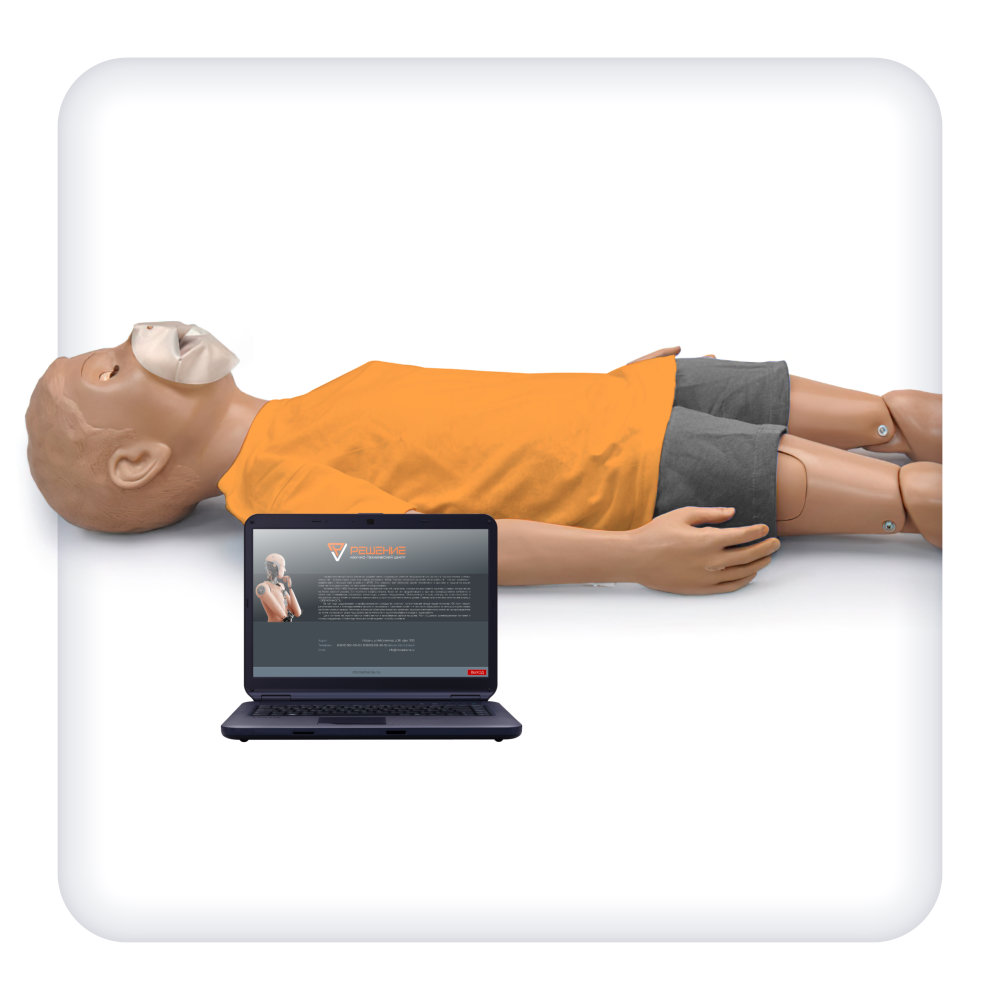Robot simulator is a domestic development in the market of simulation medical equipment and is made as a model of a teenager of 8-10 years. The upper and lower limbs of the dummy are mobile in the main joints, which makes it possible to practice the skills of transporting victims and providing first aid for dislocations and fractures. A face mask with a valve and replaceable airways eliminate the risk of cross-infection during group classes. The simulator is made of a homogeneous material-plastisol, which in its physical properties is close to the natural values of human skin.
Functional features:
Compliance with anatomical guidelines necessary for teaching resuscitation skills:
- angle of the lower jaw and laryngeal cartilage, sternocleidomastoid muscles;
- costal arches, xiphoid process.
The body of the training dummy includes various indicators that reflect the correct and erroneous actions of the students:
- with sufficient strength and depth of compression, a pulse wave is recorded on the carotid artery and the corresponding indicator on the chest of the simulator lights up;
- if the ventilator is performed correctly, the chest is raised and the corresponding indicator lights up;
- in the case of “xiphoid process fracture“, the red indicator lights up and a beep sounds;
- when a ” rib fracture“ occurs, the red indicator lights up and a beep sounds;
- the effectiveness of resuscitation is determined by the “narrowing of the pupils” and the appearance of a pulse on the carotid artery;
- in a unconscious state, the simulator must be turned over on its stomach within 30 seconds, if this does not happen, the mannequin signals the onset of death: the pulse on the carotid artery disappears, the pupils dilate and the voice accompaniment informs about this;
- in case of incorrect handling of the “damaged limb” when applying a splint to the ankle joint and lower leg, the voice accompaniment reports “pain” and a red glow of the “damaged” limb appears;
- if the “femoral artery bleed” is not stopped within 2 minutes, the carotid artery pulse disappears.
- Carrying out an extended complex of medical manipulations, including: intravenous injections in the forearm, intramuscular injections in the deltoid muscle and thigh, intraosseous injections in the tibia.
Simulator Dummy Modes:
- “Clinical death” with the display of right and wrong actions-training
If the chest compressions are performed correctly, a pulse wave appears on the carotid artery, and the green indicator lights up. If the ventilator is performed correctly, the chest is guided and the indicator light lights up. In the case of effective resuscitation in the allotted time-2 minutes (if no mistakes were made), an independent pulse appears on the carotid artery and the pupils “narrow”. This condition persists for one minute, then it changes to the initial state of “clinical death”. This mode is also displayed in the software.
- “Clinical death” without displaying correct and incorrect actions-exam
In this mode, there is no LED indication or display of actions in the software.
Effective resuscitation measures can be judged by the appearance of a pulse wave on the carotid artery.
- Ventilator-free resuscitation
Resuscitation, in which no ventilator is performed. If the chest compressions are performed correctly, a pulse wave appears on the carotid artery, and the green indicator lights up. To successfully perform resuscitation actions, it is necessary to perform 200 compressions in the allotted 2 minutes.
- “Unconscious state“
After switching on the mode for 30 seconds, the simulator must be turned on its stomach, thereby eliminating the risk of fluid aspiration into the upper respiratory tract and the risk of clogging them with the root of the tongue. The pulse on the carotid artery is maintained for 10 minutes. If the simulator is not turned over on its stomach in the allotted 30 seconds, the voice accompaniment informs us about the onset of “death”.
- “Fracture of the tibia and fibula“
In this mode, for the allotted 10 minutes, it is necessary to apply a splint or a tight bandage to the “damaged limb” without causing “pain”. It is intended for practicing the skills of applying bandages and splints in case of a broken shin bone.
If the number of incorrect actions exceeds 5, then the simulator loses the pulse on the carotid artery, dilates the pupils and an audible signal appears, indicating critical complications of traumatic shock.
- “Clinical death and bleeding from the femoral artery”
CPR measures are similar to the first mode, however, after ” reviving”, the exercise dummy “opens bleeding from the femoral artery”, which must be stopped within two minutes by applying a tourniquet through the supporting object. After 50 seconds, the simulator again comes ” clinical death”, so you need to constantly monitor the pulse on the carotid artery.
- “Bleeding from the femoral artery“
After switching on this mode, it is necessary to stop the bleeding for 2 minutes by applying a tourniquet through the supporting object.
Equipment:
- Robot simulator
- Laptop
- USB cable for connecting to the computer
- AA batteries (4 pcs.)
- Transport bag made of wear-resistant fabric
- Hemostatic tourniquet
- First aid kit
- A computer program that provides visualization, control, and evaluation of the student’s actions when providing first aid to the victim
Documentation:
- Passport of product
- User Manual
Material:
Two-component cold-cured plastic, PVC-plastisol
Dimensions, mm:
1200 x 400 x 200
Weight, kg:
15



